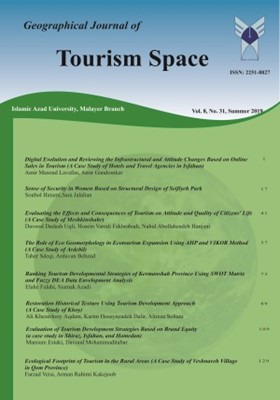Ecological footprint of the tourism in the rural area
Case study: Veshnaveh village (Qom County)
Subject Areas :
farzad vaisi
1
,
arman rahimi
2
*
1 - Assistant professor of Payame Noor University,Tehran, Iran
2 - MS of Urbanism, Kordestan University, the expert of Civil Department at Kordestan Provincial Government, Iran
Received: 2017-04-23
Accepted : 2019-07-02
Published : 2019-08-23
Keywords:
Sustainable Tourism,
environmental impact assessment,
Ecological footprint,
Veshnaveh village,
Qom provience,
Abstract :
Therefore, many empirical studies and actions have been taken to exploit the concept of sustainable development and its evaluation models. However, despite all these measures, the results from the progress towards sustainability have not been favorable. On the other hand, the first studies in the country indicate that there are major challenges in achieving sustainable tourism development, especially in the villages of tourism destination. In this research, it has been tried to investigate the environmental impact of the tourism on the village of Voshveh by a descriptive-analytical method, based on documentary library studies as well as field observations (distribution of the questionnaire and interview with the village council and tourists). The model of the ecological footprint model is estimated. The statistical population of this research is the number of tourists who visited Voshveh village in 2012. Considering that in the year 2012, 10,000 tourists entered the village, so using the Cochran formula, the sample size was estimated to be 350. The findings of this study indicate that the ecological footprints of tourism in the village of Wandshwa in food, transport, heating, water, electricity, and waste generation groups were 1.08 (per capita of each tourist) ha. Comparing this amount with its supporting environment indicates that tourism in the village of Wandshwa relies on an area beyond the village to meet its biological and environmental sustainability needs.
References:
اسماعیلزاده، حسن، سرور، رحیم (1390)؛ ارزیابی اثربخشی کنفرانسهای بینالمللی در توسعه گردشگری طبیعت محور. فصلنامه فضای گردشگری، سال اول، شماره 1: 141-115.
تقوایی، مسعود، صفرآبادی، اعظم (1390)؛ نقش مدیریت شهری در دستیابی به توسعه پایداری گردشگری شهری مطالعه موردی: شهر کرمانشاه، مجله جغرافیای مناطق خشک سال اول، شماره 4: 52-35.
رضوانی، محمدرضا، سلمانی، محمد، قنبری نسب، علی، باغیانی حمیدرضا (1389). جای پای بوم شناختی؛ رویکردی نو برای سنجش اثرات زیست محیطی (مفهوم، کاربرد و سنجش آن). فصلنامه جغرافیا و توسعه شماره 20: 166-145.
سرایی، محمد حسین، زارعی فرشاد (1388)؛ جای پای بوم شناختی (EF) به عنوان شاخص سنجش پایداری اجتماعات. مجله محیط شناسی، شماره 50: 26-15.
عیسیلو، علی اصغر، صمدی نسب، تقی، بی باک، وحید (1391)، طرح هادی- گردشگری روستای وشنوه، بنیاد مسکن انقلاب اسلامی استان قم.
شکور، علی، قریشی، محمد باسط، لشکری، مریم و جعفری، مهتاب.1390.ارزیابی و سنجش چگونگی پایداری گردشگری در بهشت گمشده بوان ممسنی با استفاده از مدل ردپای اکولوژیک، فصلنامه نگرش های نو در جغرافیای انسانی، سال سوم، شماره سوم.
بل، سیمون و موریس، استفان،(1385)، سنجش پایداری، ترجمه:شاهنوشی، ناصر و آذریف فر، یدالله، انتشارات دانشگاه فردوسی مشهد، شماره 482،ص40.
بدری، سیدعلی و افتخاری، عبدالرضا رکن الدین،(1382)، ارزیابی پایداری:مفهوم و روش، فصلنامه تحقیقات جغرافیایی، شماره 69، ص34-9.
بدری، سید علی، مطیعی لنگرودی، سیدحسن، سلمانی، محمد و علیقلی زاده فیروزجایی، ناصر،(1388)، اثرات اقتصادی گردشگری بر نواحی روستایی، مجله جغرافیا و توسعه ناحیه ای، شماره دوازدهم،ص35-14.
Hadley, S.W., Erickson III, D.J., Hernandez, J.L., Thompson, S.L., 2004. Future U.S. energy use for 2000–2025 as computed with temperatures from a global climate prediction model and energy demand model. Paper presented at 24th US AEE/IAEE North American Conference, Washington, DC.
Holden, E., 2004. Ecological footprints and sustainable urban form. Journal of Housing and the Built Environment.
Hunter, C., Shaw, J., 2007. The ecological footprint as a key indicator of sustainable tourism. Tourism Management 28: 46–57.
Johnson, P.A., 2003. Exploring the ecological footprint of tourism in Ontorio. A thesis presented to the University of Waterloo in fulfilment of the thesis requirement for the degree of Master of Arts in Geography.
Lenzen, M., 2003. The Ecological Footprint – Issues and Trends. The University of Sydney. isa.org.usyd.edu.au
Martın-Cejas, R.R., Ramırez Sanchez., P.P., 2010. Ecological footprint analysis of road transport related to tourism activity: The case for Lanzarote Island. Tourism Management 31:98–103
Meehl, G.A., Stocker, T.F., Collins, W.D., Friedlingstein, P., Gaye, A.T., Gregory, J.M., Kitoh, A., Knutti, R., Murphy, J.M., Noda, A., Raper, S.C.B., Watterson, I.G., Weaver, A.J., Zhao, Z.-C., 2007. Global climate projections. In: Solomon, S., Qin, D., Manning, M., Chen, Z., Marquis, M., Averyt, K.B., Tignor, M., Miller, H.L. (Eds), Climate Change 2007: The Physical Science Basis. Contribution of Working Group I to the Fourth Assessment Report of the Intergovernmental Panel on Climate Change. Cambridge University Press,Cambridge, United Kingdom.
Neto, F., 2003. A new approach to sustainable tourism development: move beyond environmental protection. Natural Resources Forum 27:212-222.
Peng, L., Guihua, Y., 2007. Ecological footprint study on tourism itinerary products in Shangri-La, Yunnan Province, China. Acta Ecologica Sinica, 27: 2954−2963.
Ryan, B., 2004. Ecological footprint analysis: An Irish rural study. Irish Geography 37:223-235.
Venetoulis, J., Talberth, J., 2008. Refinining the ecological footprint. Environmental development sustainable 10: 441-469.
Gossling, S & Hansson, C & Horstmeier, O and Saggel, S.2002. Ecological footprint analysis as a tool to assess tourism sustainability, Ecological Economies, Vol43, pp199-211.
Hanandeh, A.E.2013. Quantifying the carbon footprint of religious tourism: the case of Hajj, Journal of cleaner Production, in press.
Patterson, T & Niccolucci, V and Bastianoni, S.2007. Beyond more is better: Ecological footprint accounting for tourism and consumption in Val di Merse, Italy, Ecological Economies, Vol 62, pp 745-756.
John J.Pigram and Salah Wahab.( 2005) SUSTAINABLE TOURISM IN A CHANGING WORLD, TOURISM, DEVELOPMENT AND GROWTH ; The Challenge of Sustainability, Edited by Salah Wahab and John J.Pigram, London and New York.
G. Ko, James, Assessing Progress of Tourism Sustainability,Elsevier Science Ltd. All rights reserved ,Annals of Tourism Research, Vol. 28, No. 3, pp. 817–820, 2001
_||_

